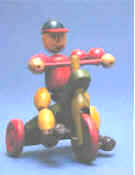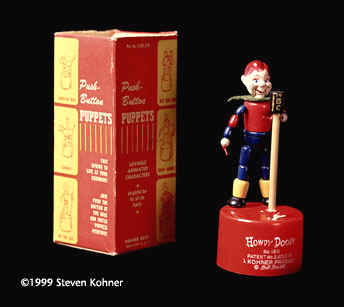|
This Kohner Brothers Company history was written for me by Frank Kohner , one of the two founding Kohner brothers. Also, many thanks to Steve Kohner, son of the other founding brother, Paul Kohner, for introducing me to Mr. Kohner and for editing this history. Kohner Wood Toys, which were made between 1946 and about 1956
have a Early Years Kohner Bros. traces its origins to a small town in the then As a teenager, Moritz Kohner in 1851 was lured by the
tales of the gold rush in America and he traveled all the way to California to
dig for gold. He did not find any riches in California and went back home a year
later. There he found gold of a different kind. In those days there were an
abundance of maple, birch and beech trees growing in the
In 1890 Moritz’s sons Emil and Max joined the business and it
then became known as M. Kohner & Sons. Moritz Kohner died in 1900 and his
son Emil took over running the business. During World War I, Emil had to
join the Austrian-Hungarian army but after the war the Tachau wood industry
revived quickly. After the war the town of Tachau became part of the newly
founded nation of Czechoslovakia. Emil and his wife Rosa had a son Paul
who
Their
first toys were simple string bead toys but by 1946-47 they had designed a few
pull toys
Push Button Puppets Fortune smiled on the brothers when they obtained the rights from the Swiss inventor, Marty Meinard, to produce the line of toys to be called Push Button Puppets. The first ones were produced around 1947. Fisher Price and as many as 28 other toy makers tried to copy their designs which the brothers tried to stop, and did stop some, by many court actions. However, many knock-offs were produced. Some manufacturers called theirs Push Up Puppets, perhaps in an attempt to demonstrate that their toys were somehow different from Kohner's. Sales for puppets rose to $50,000 in the 1950s. Over 400 workers at the Kohner factories worked hard to satisfy demand.
The photo at the left is a great Kohner Howdy Doody Push Button puppet from Steve Kohner's collection. This toy is especially desirable since it still has its original box. This toy is also interesting since it is a transition piece produced between 1956 and 1960. Its base and head are plastic while all other components are wood. Push Button Puppets are still being manufactured by many companies throughout the world. A myriad of different animals and characters have served as puppets. A good site to see photos and histories of many Push Button Puppets by Kohner and others is Jane Coakeley's at www.pushpuppets.com. Plastic After World War II more and more toys were being made in plastic
by Their greatest success was the “Busy Box” (10 activities for infants) and the still popular game of “Trouble”. The Later Years Kohner Bros. Inc. was sold to General Foods in 1969 who resold
it a few years later. Kohner Bros. does not exist anymore, but several of their
products are still
|
 Toy Making
Toy Making  featuring a swinging clown. The clown image appeared on their company literature
from these years on. Their best selling wooden pull toy by far was Tricycle Tom.
Tom featured the famous Kohner Brothers beads for legs and arms.
featuring a swinging clown. The clown image appeared on their company literature
from these years on. Their best selling wooden pull toy by far was Tricycle Tom.
Tom featured the famous Kohner Brothers beads for legs and arms. At the same time, Swedish Toy Company, began making
Push Button Puppets under Marty Meinard's patent.
At the same time, Swedish Toy Company, began making
Push Button Puppets under Marty Meinard's patent.